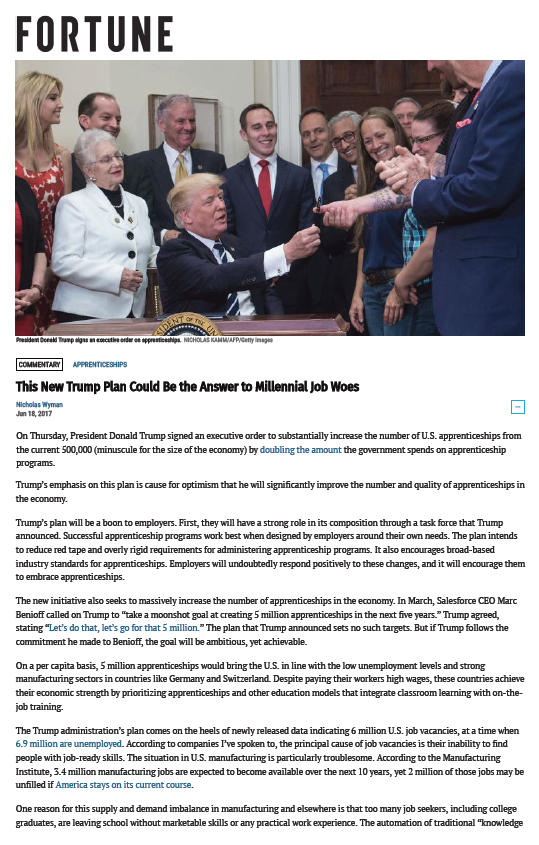Source: Fortune Magazine – http://fortune.com/2017/06/18/donald-trump-apprenticeships-programs-executive-order-millennials-news/

On Thursday, President Donald Trump signed an executive order to substantially increase the number of U.S. apprenticeships from the current 500,000 (minuscule for the size of the economy) by doubling the amount the government spends on apprenticeship programs.
Trump’s emphasis on this plan is cause for optimism that he will significantly improve the number and quality of apprenticeships in the economy.
Trump’s plan will be a boon to employers. First, they will have a strong role in its composition through a task force that Trump announced. Successful apprenticeship programs work best when designed by employers around their own needs. The plan intends to reduce red tape and overly rigid requirements for administering apprenticeship programs. It also encourages broad-based industry standards for apprenticeships. Employers will undoubtedly respond positively to these changes, and it will encourage them to embrace apprenticeships.
The new initiative also seeks to massively increase the number of apprenticeships in the economy. In March, Salesforce CEO Marc Benioff called on Trump to “take a moonshot goal at creating 5 million apprenticeships in the next five years.” Trump agreed, stating “Let’s do that, let’s go for that 5 million.” The plan that Trump announced sets no such targets. But if Trump follows the commitment he made to Benioff, the goal will be ambitious, yet achievable.
On a per capita basis, 5 million apprenticeships would bring the U.S. in line with the low unemployment levels and strong manufacturing sectors in countries like Germany and Switzerland. Despite paying their workers high wages, these countries achieve their economic strength by prioritizing apprenticeships and other education models that integrate classroom learning with on-the-job training.

The Trump administration’s plan comes on the heels of newly released data indicating 6 million U.S. job vacancies, at a time when 6.9 million are unemployed. According to companies I’ve spoken to, the principal cause of job vacancies is their inability to find people with job-ready skills. The situation in U.S. manufacturing is particularly troublesome. According to the Manufacturing Institute, 3.4 million manufacturing jobs are expected to become available over the next 10 years, yet 2 million of those jobs may be unfilled if America stays on its current course.
One reason for this supply and demand imbalance in manufacturing and elsewhere is that too many job seekers, including college graduates, are leaving school without marketable skills or any practical work experience. The automation of traditional “knowledge jobs” will only exaggerate this gap. In an apprenticeship, participants are earning and learning both on and off the job. This differs from many other employment-related programs and purely classroom-based education.
In most cases, skills that could bridge the gap are of the “middle” type. This means high-school plus: nurses, medical technicians, welders, electricians, machinists, robotics programmers, plumbers, computer technicians, and dozens more. These people enjoy above-average incomes and job security. Many out-earn their peers with four-year college degrees.
The most cost-effective way to obtain such highly sought after middle skills is through a company-sponsored apprenticeship. This typically three- or four-year endeavor allows the apprentice to acquire new skills under the watchful eyes of a trained mentor. One or two days each week are dedicated to classwork at a local community college or technical school, but no college debt is accrued. Better still, apprentices earn while they learn, and most (90%) are gainfully employed by the conclusion of their apprenticeship. How many four-year college students can say the same?
Apprenticeships are sound business investments. A recent Canadian study of over 1,000 employers across more than a dozen different fields found a net return of 47 cents for every dollar invested in apprenticeship training. Even government is a winner when it supports apprenticeships. Every $1 government invests in apprenticeships generates $27 in economic growth.
This new program comes at a perfect time; modern apprenticeships are gaining steam in the U.S. For Trump’s initiative to be consistently effective across the board, however, his administration will need to create a national custodian to ensure user-friendly norms are established and businesses are held accountable for high-impact apprenticeship outcomes. The program has the potential to meet the escalating demand for job-ready candidates in all kinds of industries and enable millions of families to achieve economic security.
Nicholas Wyman is author of Job U: How to Find Wealth and Success By Developing the Skills Companies Actually Need and CEO of the Institute for Workplace Skills and Innovation.
